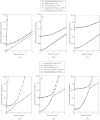Coupled oscillations of a protein microtubule immersed in cytoplasm: an orthotropic elastic shell modeling
- PMID: 23729907
- PMCID: PMC3388192
- DOI: 10.1007/s10867-012-9263-y
Coupled oscillations of a protein microtubule immersed in cytoplasm: an orthotropic elastic shell modeling
Abstract
Revealing vibration characteristics of sub-cellular structural components such as membranes and microtubules has a principal role in obtaining a deeper understanding of their biological functions. Nevertheless, limitations and challenges in biological experiments at this scale necessitates the use of mathematical and computational models as an alternative solution. As one of the three major cytoskeletal filaments, microtubules are highly anisotropic structures built from tubulin heterodimers. They are hollow cylindrical shells with a ∼ 25 nm outer diameter and are tens of microns long. In this study, a mechanical model including the effects of the viscous cytosol and surrounding filaments is developed for predicting the coupled oscillations of a single microtubule immersed in cytoplasm. The first-order shear deformation shell theory for orthotropic materials is used to model the microtubule, whereas the motion of the cytosol is analyzed by considering the Stokes flow. The viscous cytosol and the microtubule are coupled through the continuity condition across the microtubule-cytosol interface. The stress and velocity fields in the cytosol induced by vibrating microtubule are analytically determined. Finally, the influences of the dynamic viscosity of the cytosol, filament network elasticity, microtubule shear modulus, and circumferential wave-number on longitudinal, radial, and torsional modes of microtubule vibration are elucidated.
Keywords: Cell mechanics; Coupled frequency; Microtubule-cytoplasm system; Orthotropic elastic shell.
Figures






Similar articles
-
A higher-order mathematical modeling for dynamic behavior of protein microtubule shell structures including shear deformation and small-scale effects.Math Biosci. 2014 Jun;252:67-82. doi: 10.1016/j.mbs.2014.03.005. Epub 2014 Mar 20. Math Biosci. 2014. PMID: 24657874
-
Microtubule circumferential vibrations in cytosol.Proc Inst Mech Eng H. 2012 Aug;226(8):589-99. doi: 10.1177/0954411912449945. Proc Inst Mech Eng H. 2012. PMID: 23057232
-
Wave propagation in protein microtubules modeled as orthotropic elastic shells including transverse shear deformations.J Biomech. 2011 Jul 7;44(10):1960-6. doi: 10.1016/j.jbiomech.2011.05.003. Epub 2011 May 31. J Biomech. 2011. PMID: 21632054
-
Excitation of vibrations in microtubules in living cells.Bioelectrochemistry. 2004 Jun;63(1-2):321-6. doi: 10.1016/j.bioelechem.2003.09.028. Bioelectrochemistry. 2004. PMID: 15110296 Review.
-
On and around microtubules: an overview.Mol Biotechnol. 2009 Oct;43(2):177-91. doi: 10.1007/s12033-009-9193-5. Epub 2009 Jun 30. Mol Biotechnol. 2009. PMID: 19565362 Review.
Cited by
-
Deformation pattern in vibrating microtubule: Structural mechanics study based on an atomistic approach.Sci Rep. 2017 Jun 26;7(1):4227. doi: 10.1038/s41598-017-04272-w. Sci Rep. 2017. PMID: 28652626 Free PMC article.
-
Electro-acoustic behavior of the mitotic spindle: a semi-classical coarse-grained model.PLoS One. 2014 Jan 30;9(1):e86501. doi: 10.1371/journal.pone.0086501. eCollection 2014. PLoS One. 2014. PMID: 24497952 Free PMC article.
-
Comparison of translational and rotational modes towards passive rheology of the cytoplasm of MCF-7 cells using optical tweezers.Front Phys. 2023 Jan 9;10:1099958. doi: 10.3389/fphy.2022.1099958. Front Phys. 2023. PMID: 36685106 Free PMC article.
References
-
- Pokorný J, Hašek J, Jelínek F. Endogenous electric field and organization of living matter. Electromagnetic Biology and Medicine. 2005;24:185–197. doi: 10.1080/15368370500379566. - DOI
-
- Alberts B, Johnson A, Lewis J, Raff M, Roberts K, Walter P. Molecular Biology of the Cell. New York: Garland Science; 2005.
LinkOut - more resources
Full Text Sources
Research Materials

